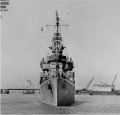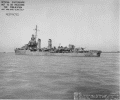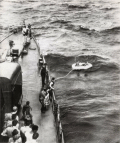Click On Image
For Full Size Image |
Size |
Image Description |
Contributed
By |
Namesake
|
 |
73k | Rear Admiral Theodorus Bailey was born in Chateaugay, New York, 12 April 1805, entering the navy as a midshipman in January 1818. He was commended for energy, enterprise, and gallantry in the Mexican-American War. Appointed captain in 1855, he was made Commodore in July 1862, and rear-admiral on the retired list, July 1866. In 1861 Captain Bailey was in command of Colorado, in the West Gulf Blockading Squadron. Later he took command of the East Gulf Blockading Squadron. He was instrumental in developing a primitive "thruster system," the principles of which are still in use today. A pipe could direct water to one side of the ship or another, which caused the ship to be able to move with more agility in the high seas. Today, ships use this principle in thruster systems. Rear Admiral Bailey died at Washington, D. C., 10 February 1877.
Photo: Library of Congress Prints and Photographs Division Washington, D.C. | Bill Gonyo |
THE SECRETARY OF THE NAVY
WASHINGTON
The Secretary of the Navy takes pleasure in commending the
UNITED STATES SHIP BAILEY
for service as follows:
"For outstanding heroism in action against enemy Japanese forces off Komandorski Islands, Bearing Sea, on March 26, 1943. With the only heavy cruiser of our small task force dead in the water following a fierce three-and-one-half-hour battle, the U.S.S. BAILEY led a determined torpedo attack against the superior Japanese surface force which was still closing our ships. Unprotected by friendly aircraft and without benefit of darkness or a smoke screen, she steamed forward at maximum speed, leading two other destroyers through a heavy barrage of hostile gunfire and concentrating her fire on the enemy’s leading heavy cruiser. Struck in rapid succession by two 8-inch shells and damaged by numerous near hits as she closed to within 9,000 yards, she launched five torpedoes and turned to retire just before two additional shell hits flooded her and rendered one engine inoperative. The only destroyer to release her torpedoes, the BAILEY succeeded in damaging one heavy cruiser and in turning back an overwhelming enemy force at the most crucial point of the battle. Her meritorious record of achievement is evidence of her own readiness for combat and the gallantry and seamanship of her officers and men."
All personnel attached to and serving on board the U.S.S. BAILEY on March 26, 1943, are authorized to wear the NAVY UNIT COMMENDATION Ribbon.
James Forrestal
Secretary of the Navy |
USS Bailey (DD-492)
|

| 103k | Undated WW2 image, location unknown. | David Buell |

| 69k | Undated WW2 image, location unknown. Taken from the 1966/67 Edition of Jane's Fighting Ships. | Robert Hurst |

| 90k | Launching at Staten Island, 19 December 1941. The keel for Beale (DD-471) is being laid in the foreground. | Ron Reeves |

| 623k | Commissioning ceremony for Bailey (DD-492) at New York Navy Yard, 11 May 1942. LCDR Franklin D. Karns, Jr., Bailey's first commanding officer, is at center. The officer reading orders is probably Rear Admiral Edward J. Marquart, New York Navy yard's commandant.
East Carolina University Digital Collections, catalog no. 0759-b1-fc | David Wright |

| 823k | USS Bailey (DD-492) underway on 12 December 1942, taken by a plane from USS Chenango (CVE-28). Bailey was underway, patrolling off the Aleutian Islands as part of Task Group 8.6. Note the extra high casing on number 2 stack, which was apparently unique to this ship.
Photographed by PhoM2/c J.S. Springer, USN. National Archives photo 80-G-264956. | Tony Cowart/Robert Hurst/Mike Green |

| 33k | USS Bailey (DD-492) while participating in the Battle of the Komandorski Islands, 26 March 1943. | Robert Hurst |

| 132k | Battle damage to USS Bailey (DD-492) upon her arrival at Mare Island, 09 April 1943. Bailey was hit four times by Japanese cruiser fire during the battle of the Komandorski Islands, flooding her forward engineroom and killing one officer and three enlisted men, one more subsequently dying of his wounds. | Darryl Baker |

| 85k | Plan view (forward) of USS Bailey (DD-492) at Mare Island, 02 July 1943. Circled areas were modified at the yard during the overhaul period from 8 April until 13 July 1943. | Darryl Baker |

| 118k | Plan view (aft) of USS Bailey (DD-492) at Mare Island, 02 July 1943. Circled areas were modified at the yard during the overhaul period from 8 April until 13 July 1943. | Darryl Baker |



Three views of the USS Bailey (DD-492) in the Mare Island channel, 04 July 1943. Bailey was underway that day for post-repair dock trials and radar calibration. | Darryl Baker |

| 110k | USS Bailey (DD-492) at Mare Island, 04 July 1943. Photo from NARA San Francisco, Mare Island Naval Shipyard Ship Files. | Tracy White |
 |
127k | Naval Gun Fire Support (NGFS) plan for the invasion of Saipan, 15 June 1944. | Wayne VanDerVoort |

| 93k | Broadside view of USS Bailey (DD-492) showing strafing damage, November 1944. Navy photo 7525-44 | Darryl Baker |




Four views of the USS Bailey in a post-yard overhaul series from December 1944. Her overhaul seems to be one of the last occasions that a dazzle scheme pattern was introduced to a tin can.
Photos from National Archives 19-LCM files. | Dave Schroeder and John Chiquoine |

| 78k | Bow on view of USS Bailey (DD-492) off Mare Island, 08 December 1944. She was in overhaul at Mare Island from 25 Oct. until 11 Dec 1944.
Navy Photo 7527-44 | Darryl Baker |

| 81k | Stern view of USS Bailey (DD-492) off Mare Island, 08 Dec 1944. Navy Photo 7532-44 | Darryl Baker |

| 71k | USS Bailey (DD-492) at Mare Island, 08 December 1944. Photo from NARA San Francisco, Mare Island Naval Shipyard Ship Files. | Tracy White |

| 375k | USS Bailey (DD-492) off the Mare Island Navy Yard, California, 08 December 1944. She is painted in what appears to be a variant of Camouflage Measure 31, Design 6D. Note the high casing around the lower part of the after smokestack, a feature unique to this ship.
Naval History and Heritage Command photo NH 107415. | Robert Hurst |

| 98k | USS Bailey (DD-492) rescuing two Navy filers in the central Pacific, 31 January 1945. A TBM-1C had run out of fuel and ditched the day before between Guam and Ulithi while on a ferry flight; in poor weather, a PBY "Dumbo" search plane of VPB-23 vectored Bailey in to rescue the two, LT C.C. Taylor, USNR of CASU 51 and LT James E. Nafstad, USNR, of ComNAB Guam staff, at 1645, after they had spent more than 24 hours in the water. | Dave Wright |


 Fourteen men died in service aboard and remain on duty
Fourteen men died in service aboard and remain on duty